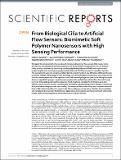| dc.contributor.author | Asadnia, Mohsen | |
| dc.contributor.author | Kottapalli, Ajay Giri Prakash | |
| dc.contributor.author | Karavitaki, K. Domenica | |
| dc.contributor.author | Warkiani, Majid Ebrahimi | |
| dc.contributor.author | Miao, Jianmin | |
| dc.contributor.author | Corey, David P. | |
| dc.contributor.author | Triantafyllou, Michael S | |
| dc.date.accessioned | 2017-05-01T18:32:34Z | |
| dc.date.available | 2017-05-01T18:32:34Z | |
| dc.date.issued | 2016-09 | |
| dc.date.submitted | 2016-04 | |
| dc.identifier.issn | 2045-2322 | |
| dc.identifier.uri | http://hdl.handle.net/1721.1/108548 | |
| dc.description.abstract | We report the development of a new class of miniature all-polymer flow sensors that closely mimic the intricate morphology of the mechanosensory ciliary bundles in biological hair cells. An artificial ciliary bundle is achieved by fabricating bundled polydimethylsiloxane (PDMS) micro-pillars with graded heights and electrospinning polyvinylidenefluoride (PVDF) piezoelectric nanofiber tip links. The piezoelectric nature of a single nanofiber tip link is confirmed by X-ray diffraction (XRD) and Fourier transform infrared spectroscopy (FTIR). Rheology and nanoindentation experiments are used to ensure that the viscous properties of the hyaluronic acid (HA)-based hydrogel are close to the biological cupula. A dome-shaped HA hydrogel cupula that encapsulates the artificial hair cell bundle is formed through precision drop-casting and swelling processes. Fluid drag force actuates the hydrogel cupula and deflects the micro-pillar bundle, stretching the nanofibers and generating electric charges. Functioning with principles analogous to the hair bundles, the sensors achieve a sensitivity and threshold detection limit of 300 mV/(m/s) and 8 μm/s, respectively. These self-powered, sensitive, flexible, biocompatibale and miniaturized sensors can find extensive applications in navigation and maneuvering of underwater robots, artificial hearing systems, biomedical and microfluidic devices. | en_US |
| dc.description.sponsorship | Singapore. National Research Foundation (Singapore-MIT Alliance for Research and Technology) | en_US |
| dc.description.sponsorship | Singapore-MIT Alliance for Research and Technology (SMART) (Innovation Grants ING148079- ENG) | en_US |
| dc.language.iso | en_US | |
| dc.publisher | Nature Publishing Group | en_US |
| dc.relation.isversionof | http://dx.doi.org/10.1038/srep32955 | en_US |
| dc.rights | Creative Commons Attribution 4.0 International License | en_US |
| dc.rights.uri | http://creativecommons.org/licenses/by/4.0/ | en_US |
| dc.source | Nature | en_US |
| dc.title | From Biological Cilia to Artificial Flow Sensors: Biomimetic Soft Polymer Nanosensors with High Sensing Performance | en_US |
| dc.type | Article | en_US |
| dc.identifier.citation | Asadnia, Mohsen et al. “From Biological Cilia to Artificial Flow Sensors: Biomimetic Soft Polymer Nanosensors with High Sensing Performance.” Scientific Reports 6.1 (2016): n. pag. | en_US |
| dc.contributor.department | Massachusetts Institute of Technology. Department of Mechanical Engineering | en_US |
| dc.contributor.mitauthor | Triantafyllou, Michael S | |
| dc.relation.journal | Scientific Reports | en_US |
| dc.eprint.version | Final published version | en_US |
| dc.type.uri | http://purl.org/eprint/type/JournalArticle | en_US |
| eprint.status | http://purl.org/eprint/status/PeerReviewed | en_US |
| dspace.orderedauthors | Asadnia, Mohsen; Kottapalli, Ajay Giri Prakash; Karavitaki, K. Domenica; Warkiani, Majid Ebrahimi; Miao, Jianmin; Corey, David P.; Triantafyllou, Michael | en_US |
| dspace.embargo.terms | N | en_US |
| dc.identifier.orcid | https://orcid.org/0000-0002-4960-7060 | |
| mit.license | PUBLISHER_CC | en_US |
